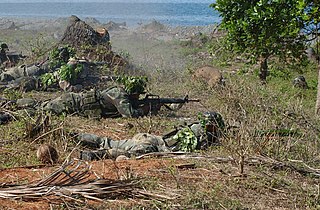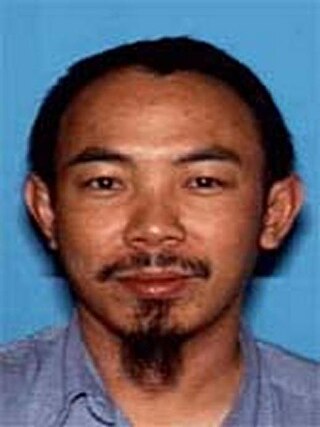
Jemaah Islamiyah is a Southeast Asian Islamist militant group based in Indonesia, which is dedicated to the establishment of an Islamic state in Southeast Asia. On 25 October 2002, immediately following the JI-perpetrated Bali bombing, JI was added to the UN Security Council Resolution 1267 as a terrorist group linked to Al-Qaeda or the Taliban.

Makati, officially the City of Makati, is a 1st class highly urbanized city in the National Capital Region of the Philippines.

The Singapore embassies attack plot was a plan in 2001 by Jemaah Islamiyah (JI) to bomb the diplomatic missions and attack personnel of the United States, Australia, the United Kingdom, and Israel based in Singapore. There were also several other targets. The plot was uncovered in December 2001 and as many as 15 people were arrested in Singapore within a month. Further investigation and intelligence prompted the detention of another 26 persons from 2002 to 2005. As of 2006, 37 of them were still being detained without trial, under the Internal Security Act. Four had been released on restriction orders.

Operation Enduring Freedom – Philippines (OEF-P) or Operation Freedom Eagle was part of Operation Enduring Freedom and the global War on Terror. The Operation targeted the various Jihadist terror groups operating in the country. By 2009, about 600 U.S. military personnel were advising and assisting the Armed Forces of the Philippines (AFP) in the Southern Philippines. In addition, by 2014, the CIA had sent its elite paramilitary officers from their Special Activities Division to hunt down and kill or capture key terrorist leaders. This group had the most success in combating and capturing Al-Qaeda leaders and the leaders of associated groups like Abu Sayyaf.

Epifanio de los Santos Avenue, commonly referred to by its acronym EDSA, is a limited-access circumferential highway around Manila, the capital city of the Philippines. It passes through 6 of Metro Manila's 17 local government units or cities, namely, from north to south, Caloocan, Quezon City, San Juan, Mandaluyong, Makati, and Pasay.

A one-tonne car bomb, which was packed into a small Daihatsu delivery van, exploded outside the Australian embassy at Kuningan District, South Jakarta, at about 10:30 local time on September 9, 2004, killing 9 people including the suicide bomber, and wounding over 150 others. The explosion gutted the Greek embassy on the 12th floor of an adjacent building, where three diplomats were slightly wounded. Damage to the nearby Chinese embassy was also reported. Numerous office buildings surrounding the embassy were also damaged by the blast, which shattered windows in buildings 500 metres (500 yd) away, injuring many workers inside, mostly by broken glass.

Rizal Day is a Philippine national holiday commemorating life and works of José Rizal, a national hero of the Philippines. It is celebrated every December 30, the anniversary of Rizal's 1896 execution at Bagumbayan in Manila.

A series of terrorist suicide bomb and a series of car bombs and attacks occurred on 1 October 2005 in Bali, Indonesia. Bombs exploded at two sites in Jimbaran Beach Resort and in Kuta 30 km (19 mi) away, both in south Bali. The terrorist attack claimed the lives of 20 people and injured more than 100 others. The three bombers also died in the attacks.
A suicide bomber detonated a car bomb outside the lobby of the JW Marriott Jakarta hotel, killing 12 people and injuring 150. Those killed including a white Dutch man while the rest were Indonesian. The hotel was viewed as a Western symbol, and had been used by the United States embassy for various events. The hotel was closed for five weeks and reopened to the public on September 8.

The Light Rail Transit Line 1, commonly referred to as LRT Line 1 or LRT-1, is a light rapid transit system line in Metro Manila, Philippines, operated by Light Rail Manila Corporation (LRMC) and owned by the Light Rail Transit Authority (LRTA) as part of the Manila Light Rail Transit System. Originally referred to as Metrorail and the Yellow Line, LRT Line 1 was reclassified to be the Green Line in 2012. It travels in a general north–south direction from Baclaran to Monumento, and then east–west from Monumento to Roosevelt. Currently, the line consists of 20 stations and runs on 19.65 kilometers of fully elevated route. Although it has the characteristics of light rail, such as with the type of rolling stock used, it is more akin to a rapid transit system owing to its total grade separation and high passenger throughput.

Dulmatin was a senior figure in the militant Islamic group Jemaah Islamiyah (JI) and one of the most wanted terrorists in Southeast Asia. He was also known as Amar Usmanan, Joko Pitoyo, Joko Pitono, Abdul Matin, Pitono, Muktarmar, Djoko, and Noval. He also had the nickname "Genius". Dulmatin was an ethnic Javanese with a height of 172 cm, weighing 70 kg, with a brown complexion.
Fathur Rahman al-Ghozi was a key operative and bomb-maker of the Islamic militant Jemaah Islamiya group (JI). Al-Ghozi was accused of plotting and carrying out several terrorist attacks in the Philippines, Indonesia, and Singapore.

Terrorism in Indonesia refer to acts of terrorism that take place within Indonesia or attacks on Indonesian people or interests abroad. These acts of terrorism often target the government of Indonesia or foreigners in Indonesia, most notably Western visitors, especially those from the United States and Australia.
The Al-Mukmin Islamic boarding school also known as Pesantren Al-Mukmin and Pondok Ngruki, is a pesantren located in Ngruki, a suburb in the regency of Sukoharjo, Central Java, Indonesia. It was founded 1972 by the alleged 'spiritual head' of Jemaah Islamiyah, Abu Bakar Bashir, and by Abdullah Sungkar. Al-Mukmin's activities were initially limited to religious discussion after dhuhr. Following increasing interest, the founders expanded Al-Mukmin into a madrasah and then into a pesantren. It currently houses over 2000 students aged between 12 and 18.

Rizal Avenue, also known as Avenida or Avenida Rizal, is one of Manila's main thoroughfares running from its Santa Cruz and Quiapo districts to the Bonifacio Monument (Monumento) Circle in Caloocan. Named after the national hero José Rizal, it is a part of Radial Road 9 (R-9). The LRT Line 1 elevated railroad is built above the street in its entire length, and several jeepneys ply the area taking passengers from Caloocan, Quezon City, and Valenzuela. Most of the street is within Santa Cruz, Manila. By the 1960s, economic activities shifted from Binondo to Makati. The avenue forms part of National Route 150 (N150) of the Philippine highway network.

Zulkifli Abdhir was a Malaysian who was one of the FBI Most Wanted Terrorists. The American Federal Bureau of Investigation (FBI) agency offered a US$5 million reward for information leading to his capture. He was the maker of bombs delivered for usage to several terrorist groups. He was often referred to by the nom de guerreMarwan. He was suspected of leading the Kumpulan Mujahidin Malaysia (KMM), being part of the central command of the Jemaah Islamiyah (JI), and of involvement in the 2002 Bali bombings. He was suspected of hiding in Mindanao under the protection of the Bangsamoro Islamic Freedom Fighters.

Senator Gil J. Puyat Avenue, also known simply as Gil Puyat Avenue and formerly and still referred to as Buendia Avenue, is a major arterial thoroughfare which travels east–west through the cities of Makati and Pasay in western Metro Manila, Philippines. It is one of the busiest avenues in Metro Manila linking the Makati Central Business District with the rest of the metropolis.

Avenida Antonio Arnáiz Somoza, or simply Avenida Arnáiz, formerly known as Calle Libertad and then Calzada de Pásay, is a major east–west collector road that links Makati and Pasay in the Philippines. It stretches across western Metro Manila from Roxas Boulevard in Pasay to Epifanio de los Santos Avenue (EDSA) in Makati.

The Makati Central Business District is a financial and central business district in the Philippines located in the heart of Makati in Metro Manila. It is politically known as "Central Cluster" in the West District of Makati. It is different from the Makati civic center known as "Makati Poblacion" which is situated at the northeast portion of the district. It is bounded by EDSA, Gil Puyat Avenue, Arnaiz Avenue, and Chino Roces Avenue. The whole district occupies barangays of San Antonio, San Lorenzo, Bel-Air, and Urdaneta.
The Valentine's Day bombings happened on 14 February 2005 in different cities in the Philippines. Three bombs exploded on that day killing at least nine people and injuring more than a hundred. Abu Sayyaf claimed responsibility and three members of the group were convicted of murder in one bombing.
















